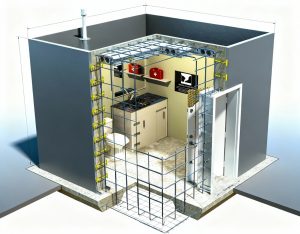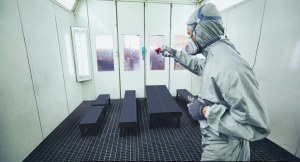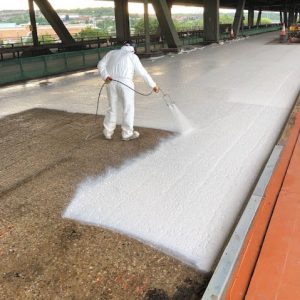Riverine and coastal floods now arrive faster and hit harder, straining levees, floodwalls, sluice gates, and pump stations built for gentler hydrologic regimes. Municipal engineers need retrofit options that add decades of service life without shutting down entire corridors for reconstruction. That’s why spray‑applied polyurea has moved to the front of that conversation; it bonds to concrete, steel, and even compacted soil, forming a seamless elastomeric skin in as little as a few seconds. Here we’ll distill the key specification and field‑practice considerations that turn the chemistry’s headline properties into durable, code‑compliant flood protection that saves money as reliably as it saves lives.
IN SHORT: WHY POLYUREA BEATS TRADITIONAL LININGS
Polyurea’s amine–isocyanate reaction creates long, spring-like urea linkages that begin to cure almost instantaneously, allowing applicators to build 20- to 250-mil films in a single pass (thicker sections require successive lifts). Unlike epoxies that embrittle under cyclic loading, polyurea elongates well beyond 400%, flexing with wall deflection as hydrostatic pressure rises and falls. Its 100%‑solids formulation contains no volatile solvents, eliminating cure‑time weather delays and reducing environmental‑permitting hurdles.
HOW FLOOD LOADS INFORM COATING DESIGN
Flood barriers experience three distinct stresses: sustained hydrostatic pressure, dynamic scouring from sediment‑laden flow, and impact from debris or ice. The first determines minimum tensile strength and allowable strain; the second drives abrasion‑resistance targets; the third justifies optional ceramic‑ or silica‑filled formulations in high‑risk zones. Engineers should model worst‑case head differentials and overtopping scenarios, then select a product whose ultimate elongation and tear resistance remain well inside the safety factor at the specified dry‑film thickness.
SUBSTRATE ASSESSMENTS FOR CONCRETE, STEEL, AND EARTHEN BERMS
Concrete floodwalls often reveal micro‑cracks and alkali‑silica reactions that wick moisture. Moisture‑vapor‑emission rates above established thresholds call for a moisture‑tolerant primer or a temporary dewatering regime to prevent blistering. Steel sheet‑piles, by contrast, suffer chloride pitting; an abrasive blast followed by a zinc‑rich primer arrests corrosion beneath the polyurea shell. For geotextile‑wrapped earthen levees, crews typically anchor a sacrificial fleece to distribute spray heat and provide mechanical keying before shooting 80‑ to 120‑mil polyurea skins that accommodate subsoil settlement without tearing. Learn more about flood wall infrastructure coatings here.
On freshly blasted steel, a solvent wipe (e.g., acetone) removes oil and fine dust; the surface must also be visibly dry, free of condensation, before spraying. Concrete laitance, however, must be removed mechanically, typically to an ICRI CSP‑3 profile, before priming, and moisture drive should be retested to ensure adhesion integrity.
FILM-BUILD, ANCHORING, AND JOINT DETAILING
Most flood‑control specifications land between 60 mil (non‑abrasive splash zones) and 200 mil (high‑velocity spillway aprons). Film build is usually achieved in two heated passes so the molten second track fuses with, rather than merely overlaps, the first. Chamfered corners and formed keyways control shrinkage stress, and in cold joints, designers often embed polyester or aramid geotextile scrim engineered for polyurea adhesion; the membrane chemically grips the fabric, spreading movement over a wider area and raising peel strength well above several hundred psi. Penetrations, including gate stems, vent pipes, and piezometer tubes, should receive bell‑mouthed terminations and a thixotropic fillet before main spraying to prevent tenting under surge loads.
APPLICATION ENVIRONMENT AND NECESSARY EQUIPMENT
Plural‑component rigs must hold “A” and “B” sides within only a few degrees Celsius of the manufacturer’s target. At riverbanks the whip hose can chill quickly, so seasoned crews fit an auxiliary heater or shorten hose runs to maintain viscosity. Relative humidity above 85 % accelerates surface condensation, demanding stringent timing between surface prep and spray.
Because the two components meet only in the impingement chamber of a high‑pressure spray gun, any off‑ratio surge will gel instantly inside the chamber, blocking the gun and forcing an emergency shutdown. Constant pressure monitoring, proper pre‑heat, and disciplined line‑flushing are non‑negotiable safety and quality practices.
INSPECTION AND SERVICE-LIFE MONITORING
Holiday (spark) testing should follow AMPP SP0188: use 100–150 V per mil for 20–50 mil membranes and 80–100 V per mil once the film exceeds 50 mil. Pull‑off adhesion dollies should read at least 250 psi on sound concrete; anything lower flags moisture drive or an under‑profiled surface.
Once commissioned, barrier owners often integrate quarterly infrared scans; temperature anomalies flag undermining seepage behind the coating long before stains appear on the dry side. Because polyurea is chemically inert, patch repairs with the original formulation weld to the existing skin without abrasive scarification when performed inside the manufacturer’s open‑recoat window.
IMPLICATIONS ON SUSTAINABILITY AND FUNDING
Life extending retrofits can qualify as capital resilience upgrades under US and EU programs, rather than as regular and uncategorized routine maintenance. Positioning the project as hazard‑mitigation and documenting risk reduction, lifecycle savings, and environmental compliance are key to unlocking favorable cost‑share ratios.
Polyurea’s solvent‑free nature reduces VOC inventories and, in many cases, carries potable‑water approvals, which is critical when floodwalls double as reservoir bathtubs. For green‑infrastructure hybrids, polyurethane binders such as open‑pore Elastocoast can reinforce riprap revetments, absorbing wave energy while preserving percolation and habitat value. Combining sealed floodwalls with energy‑dissipating riverbank armor yields layered defenses that defer costly height increases.
A TRULY LIFESAVING MATERIALS TECHNOLOGY
Spray‑applied polyurea is an engineered membrane whose mechanical behavior can be tuned to match exact flood‑load profiles. Success hinges on translating hydrologic data into film‑build, primer, and detailing choices and then enforcing disciplined surface preparation and QA. When those pieces align, a few millimeters of reactive polymer can deliver decades of leak‑free, corrosion‑free performance, buying communities precious time in an era when water no longer plays by the old rules.






